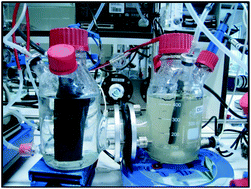当前位置:
X-MOL 学术
›
React. Chem. Eng.
›
论文详情
Our official English website, www.x-mol.net, welcomes your
feedback! (Note: you will need to create a separate account there.)
Impact of dissolved carbon dioxide concentration on the process parameters during its conversion to acetate through microbial electrosynthesis†
Reaction Chemistry & Engineering ( IF 3.4 ) Pub Date : 2018-04-05 00:00:00 , DOI: 10.1039/c7re00220c Gunda Mohanakrishna 1, 2, 3, 4, 5 , Karolien Vanbroekhoven 1, 2, 3, 4 , Deepak Pant 1, 2, 3, 4
Reaction Chemistry & Engineering ( IF 3.4 ) Pub Date : 2018-04-05 00:00:00 , DOI: 10.1039/c7re00220c Gunda Mohanakrishna 1, 2, 3, 4, 5 , Karolien Vanbroekhoven 1, 2, 3, 4 , Deepak Pant 1, 2, 3, 4
Affiliation

|
The reduction of carbon dioxide (CO2) released from industry can help to reduce the emissions of greenhouse gases (GHGs) to the atmosphere while at the same time producing value-added chemicals and contributing to carbon fixation. Microbial electrosynthesis (MES) is a recently developed process which accomplishes this idea by using cathodic bacteria at the expense of only minimum energy. In this study, enriched mixed homoacetogenic bacteria as cathodic biocatalysts for the reduction of CO2 with five different concentrations were evaluated to produce acetate at a constant potential. Increasing the carbon concentration showed an improved acetate production rate and carbon conversion efficiency. A maximum acetate production rate of 142.2 mg L per day and a maximum carbon conversion efficiency of 84% were achieved, respectively, at 4.0 and 2.5 g HCO3− L−1. The changes in pH due to interactive reactions between the bicarbonate (substrate) and acetate (products) were able to create a buffering nature in the catholyte controlling the operating parameters of the MES process, such as pH and substrate specificity. A higher acetate production shifted the catholyte pH toward acidic conditions, which further triggered favorable conditions for the bioelectrochemical reduction of acetate to ethanol.
中文翻译:

通过微生物电合成将溶解的二氧化碳浓度转化为乙酸盐过程中,溶解的二氧化碳浓度对工艺参数的影响†
从工业中释放的二氧化碳(CO 2)的减少可以帮助减少向大气排放的温室气体(GHG),同时生产增值化学品并有助于固碳。微生物电合成(MES)是最近开发的一种方法,它通过使用阴极细菌以最小的能量为代价来实现这一想法。在这项研究中,富集的混合高产乙酸细菌作为阴极生物催化剂,可减少CO 2评估了五种不同浓度的乙酸乙二酯在恒定电位下产生乙酸盐的能力。碳浓度的增加表明乙酸盐的生产率和碳转化效率得到改善。在4.0和2.5 g HCO 3 - L -1下,分别达到每天142.2 mg L的最大乙酸盐生产率和84%的最大碳转化效率。。由于碳酸氢盐(底物)和乙酸盐(产品)之间相互作用而引起的pH值变化,能够在控制MES工艺操作参数(例如pH值和底物特异性)的阴极电解液中产生缓冲性质。较高的乙酸盐产量将阴极电解液的pH移至酸性条件,这进一步触发了将乙酸盐生物化学还原为乙醇的有利条件。
更新日期:2018-04-05
中文翻译:

通过微生物电合成将溶解的二氧化碳浓度转化为乙酸盐过程中,溶解的二氧化碳浓度对工艺参数的影响†
从工业中释放的二氧化碳(CO 2)的减少可以帮助减少向大气排放的温室气体(GHG),同时生产增值化学品并有助于固碳。微生物电合成(MES)是最近开发的一种方法,它通过使用阴极细菌以最小的能量为代价来实现这一想法。在这项研究中,富集的混合高产乙酸细菌作为阴极生物催化剂,可减少CO 2评估了五种不同浓度的乙酸乙二酯在恒定电位下产生乙酸盐的能力。碳浓度的增加表明乙酸盐的生产率和碳转化效率得到改善。在4.0和2.5 g HCO 3 - L -1下,分别达到每天142.2 mg L的最大乙酸盐生产率和84%的最大碳转化效率。。由于碳酸氢盐(底物)和乙酸盐(产品)之间相互作用而引起的pH值变化,能够在控制MES工艺操作参数(例如pH值和底物特异性)的阴极电解液中产生缓冲性质。较高的乙酸盐产量将阴极电解液的pH移至酸性条件,这进一步触发了将乙酸盐生物化学还原为乙醇的有利条件。











































 京公网安备 11010802027423号
京公网安备 11010802027423号